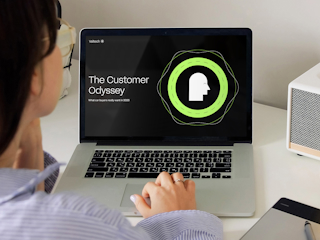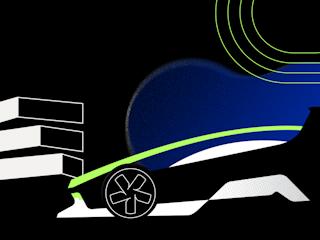Our new global report, The Customer Odyssey, surveyed more than 1,000 buyers and intenders in Europe and the United States. The findings point to a clear path forward: leaders who combine digital-first journeys, trusted human interaction, practical voice and AI experiences and transparent monetization will win the loyalty of tomorrow’s drivers.
Key insights from the report
- 57% in Europe want to purchase their next car fully online
- 81% still expect human reassurance at critical decision points
- 91% intend to use in-car voice assistants for everyday tasks
- 89% are ready to embrace AI-powered driving services
- 65% are willing to pay €11-30 per month for digital features
Digital-first journeys are now the default
More than half of car buyers, and 57% in Europe, want their next purchase to happen entirely online. This marks a dramatic shift in behavior with the dealership no longer the anchor of the buying process. The car has entered the world of e-commerce.
This is not simply about offering a digital checkout. It’s about the complete reinvention of the customer journey, from inspiration and comparison to configuration, financing and delivery. Car buyers want the autonomy, transparency and simplicity they already experience in other digital categories. They expect car brands to remove friction, reduce uncertainty and make the purchase process feel effortless.
For executives, this signals that the competitive battleground is no longer just product quality but also customer journey design. The winners will be brands that deliver a fully digital buying experience without losing emotional connection. This shift demands an organizational pivot: original equipment manufacturers (OEMs) must think like digital retailers, creating end-to-end ecosystems rather than disconnected touchpoints.
Human reassurance still seals the deal
Even in this digital-first reality, human reassurance remains critical. 81% of buyers expect direct access to a human when making a purchase decision. They want expertise, negotiation and the confidence that comes from personal interaction at pivotal moments.
This finding underscores that digital convenience and human connection are not opposites. They are complementary. Car buyers want to control the journey on their own terms but they also want the option to pause and consult a real person when it matters most. This is especially true in moments of financial or technical complexity, such as configuring a car or finalizing payment.
This means rethinking how human support is embedded into digital models. The role of people must evolve from sales agents to trusted advisors, accessible through chat, video or messaging channels. The most successful brands will be those that design hybrid journeys, where human empathy and digital efficiency coexist seamlessly.
Voice becomes the interface
The transformation does not stop at the point of sale. Inside the vehicle, expectations are accelerating just as quickly. 91% of drivers want to use voice assistants. The preferred use cases are highly practical, such as checking recall status, reserving charging stations or paying for tolls and parking.
This signals a fundamental change in how consumers want to interact with technology. Drivers are no longer content to navigate menus or screens. They expect natural, conversational interfaces that make life easier. Voice has become the most intuitive way to manage increasingly digital cars and it’s setting the stage for the next wave of in-car experience design.
This means that cockpit innovation can no longer be about novelty or entertainment value. The voice experience must be useful, reliable and tightly integrated into daily driving behavior. Voice is quickly becoming the primary interface of the mobility ecosystem. The way customers engage with the brand every time they drive. Brands that treat it as a serious design discipline, not a side feature, will define the new standard for convenience and safety.
AI is the new co-pilot
Artificial intelligence follows the same trajectory. 89% of respondents say they are ready to use AI-powered services in the car. Popular features include predictive notifications, personalized navigation and adaptive comfort settings. These are no longer “nice-to-have” additions. They are fast becoming baseline expectations.
This readiness signals a clear cultural shift: consumers are open to machine intelligence when it is helpful, transparent and improves their experience. AI is seen as practical not futuristic. It’s the invisible co-pilot that anticipates needs, reduces friction and enhances confidence behind the wheel.
The key takeaway here is strategic focus. The opportunity is not to flood vehicles with AI features but to prioritize use cases that genuinely add value. Customers want AI to empower, not overwhelm. The next competitive edge lies in making AI feel human in its intuition but precise in its function, so that it becomes a silent partner that supports drivers rather than distracts them.
The monetization sweet spot
65% of respondents are willing to pay between €11 and €30 per month for digital services. This willingness spans across markets but is strongest among younger, digital-first buyers.
Customers now view digital features as part of the ownership experience, not as a bonus. The expectation is that a car will improve over time through software and services. This opens a new path to recurring revenue but only for brands that design offerings with transparency and tangible value.
This is a call for discipline in digital product strategy. The sweet spot is narrow: customers reward fairness and clarity but penalize hidden costs and complexity. Successful OEMs will package digital features into simple, meaningful bundles, pricing them where perceived value and affordability intersect. Monetization should feel like service not sales.
Winning in the next era of mobility
The future of mobility will not be won through innovation alone but through execution that feels effortless. Customers may be ready for AI-driven experiences, but their trust still depends on the reliability of the fundamentals: the speed, stability and simplicity that make technology invisible.
As expectations evolve from control and safety toward intelligence and personalization, the definition of value is shifting from mechanical to digital. The brands that master this transition — delivering consistency before complexity, substance before spectacle — will turn everyday reliability into a lasting competitive advantage.
OEMs need to make digital excellence the new measure of trust and the foundation of loyalty in the mobility era. Those that succeed will redefine mobility for the decade ahead.
David Toma is the Vice President Strategy & Consulting at Valtech in the DACH region, where he helps shape the next era of mobility at the intersection of business, technology and transformation.











